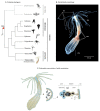Nematostella vectensis, an Emerging Model for Deciphering the Molecular and Cellular Mechanisms Underlying Whole-Body Regeneration
- PMID: 34685672
- PMCID: PMC8534814
- DOI: 10.3390/cells10102692
Nematostella vectensis, an Emerging Model for Deciphering the Molecular and Cellular Mechanisms Underlying Whole-Body Regeneration
Abstract
The capacity to regenerate lost or injured body parts is a widespread feature within metazoans and has intrigued scientists for centuries. One of the most extreme types of regeneration is the so-called whole body regenerative capacity, which enables regeneration of fully functional organisms from isolated body parts. While not exclusive to this habitat, whole body regeneration is widespread in aquatic/marine invertebrates. Over the past decade, new whole-body research models have emerged that complement the historical models Hydra and planarians. Among these, the sea anemone Nematostella vectensis has attracted increasing interest in regard to deciphering the cellular and molecular mechanisms underlying the whole-body regeneration process. This manuscript will present an overview of the biological features of this anthozoan cnidarian as well as the available tools and resources that have been developed by the scientific community studying Nematostella. I will further review our current understanding of the cellular and molecular mechanisms underlying whole-body regeneration in this marine organism, with emphasis on how comparing embryonic development and regeneration in the same organism provides insight into regeneration specific elements.
Keywords: Nematostella vectensis; anthozoa; cnidaria; functional genomics; marine organism; regeneration; sea anemone; stress response; whole-body regeneration.
Conflict of interest statement
The author declares no conflict of interest.
Figures





References
-
- Reaumur D. Sur les diverses reproductions qui se font dans les ecrivisses, les omars, les crabes, etc. et entre autres sur celles de leurs jambes et de leurs ecailles. Mem Acad. R. Des. Sci. 1712:226–245.
Publication types
MeSH terms
Grants and funding
LinkOut - more resources
Full Text Sources
Miscellaneous

